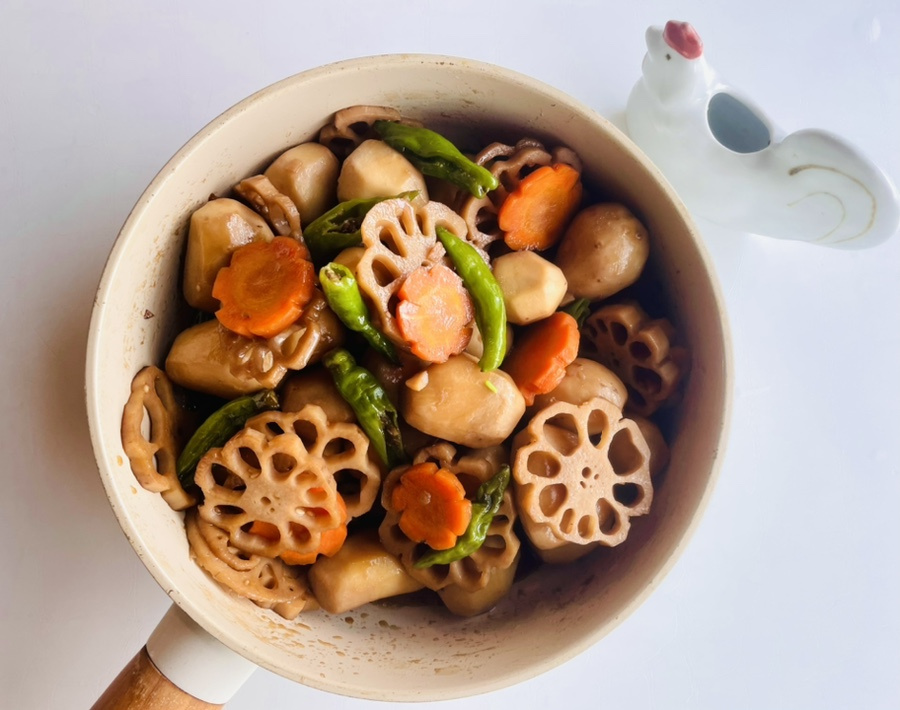Gingery Taro and Lotus Root Stew
Autumn Delicacy! How to Make a Wonderful Braised Taro and Lotus Root Dish

As Chuseok (Korean Thanksgiving) approaches, the markets are brimming with fresh taro! While taro soup is a classic for the holiday, today I’m excited to share a ‘Taro and Lotus Root Stew’ that highlights taro’s unique charm. Taro, which looks similar to potato but has a wonderfully chewy and soft texture, is easy to prepare by blanching it in boiling water and peeling – this also helps reduce concerns about skin irritation. Plus, the sticky mucin component in taro is great for our health, so let’s enjoy it deliciously!
This braised dish incorporates seasonal autumn vegetables like lotus root and carrots, along with aromatic snap peas. Slicing the round taro and lotus root, colorful carrots, and snap peas into pretty flower shapes and stir-frying them together not only makes the dish visually appealing but also enhances its flavor. The base is a sweet and savory Sukiyaki soy sauce, inspired by Japanese home cooking, but you can substitute it with Tsuyu or regular seasoned soy sauce if needed.
Packed with healthy vegetables, this taro and lotus root stew is a perfect, non-greasy, and light dish for the holidays or a delightful side dish any day. Add a burst of flavor and health to your table for special occasions or everyday meals!
Main Ingredients- 400g prepared taro
- 1 small carrot
- 1 piece (15cm) lotus root
- 2 cloves garlic, minced
- 1 Tbsp cooking oil
Braising Sauce- 2 Tbsp soy sauce
- 3 Tbsp Sukiyaki sauce (or Tsuyu/seasoned soy sauce)
- 5 Tbsp water
- 3 Tbsp mirin (rice wine)
- 1/2 Tbsp sugar
For Taro & Lotus Root Color Retention- 2 Tbsp vinegar
- 2 Tbsp soy sauce
- 3 Tbsp Sukiyaki sauce (or Tsuyu/seasoned soy sauce)
- 5 Tbsp water
- 3 Tbsp mirin (rice wine)
- 1/2 Tbsp sugar
For Taro & Lotus Root Color Retention- 2 Tbsp vinegar
Cooking Instructions
Step 1
First, soak the taro in water to remove any soil. Wear rubber gloves and wash it thoroughly multiple times until the water runs clear. It’s crucial to wear gloves as the taro skin can cause itching.

Step 2
Bring 1L of water to a boil in a large pot, adding 1 Tbsp of salt and 2 Tbsp of vinegar. Once boiling, add the taro and blanch for about 10 minutes until tender.

Step 3
Immediately transfer the blanched taro to cold water to cool it down. Drain the taro in a colander once it’s cooled. Now, peel the taro. It should peel easily by hand, but for any stubborn spots, gently scrape off the skin with a knife for a clean finish.

Step 4
Wash the lotus root thoroughly to remove any dirt, then use a knife to scrape off the outer skin.

Step 5
To prevent the peeled taro from browning, soak it in a bowl of water mixed with 2 Tbsp of vinegar for about 10 minutes. This will help maintain its appealing color when braised.

Step 6
Cut the taro into lengths of about 5-7 cm. Make long slits along the thicker sides of the taro pieces; this will help create a beautiful flower shape later.

Step 7
Slice the cut taro into thin pieces, about 2-3mm thick. This slicing method will give them a lovely flower-like appearance when cooked.

Step 8
The sliced taro should be placed back into the vinegar water to prevent browning.

Step 9
Blanch the lotus root in boiling water with 1 Tbsp of salt for about 3 minutes. Be careful not to overcook it, as it can become too soft. Rinse the blanched lotus root in cold water and drain well.

Step 10
Scrape the skin off the carrot with a knife and wash it clean. Similar to the taro, making long slits along the sides will create a pretty flower pattern.

Step 11
Slice the carrot thinly, about 2-3mm thick, to create the flower shapes.

Step 12
Soak the snap peas in vinegar water for about 5 minutes, then rinse and remove the stems. Slice them diagonally into 2-3 cm pieces. This adds color and aroma to the dish.

Step 13
Heat 1 Tbsp of cooking oil in a large pan over low heat. Add the minced garlic and sauté until fragrant, being careful not to burn it. This step builds a foundational flavor.

Step 14
Once the garlic is fragrant, add the taro (drained from the vinegar water) and sauté for about 1-2 minutes. This lightly coats the taro and prepares it to absorb the sauce.

Step 15
Add the carrots and lotus root to the pan and stir-fry them with the taro. Coating the vegetables in oil will make them glossier and tastier.

Step 16
Now, combine all the braising sauce ingredients: soy sauce, Sukiyaki sauce, water, mirin, and sugar. Stir well. Once the sauce comes to a simmer, ladle it over the vegetables, stirring gently to ensure even coating. Cover the pan and let it simmer over medium-low heat for about 10-15 minutes, or until the vegetables are tender. Check occasionally to prevent sticking.

Step 17
Finally, add the snap peas for a splash of color and stir-fry for another moment. Sauté briefly to keep them crisp and vibrant.

Step 18
Just before turning off the heat, drizzle in a little sesame oil and sprinkle with toasted sesame seeds for an added nutty aroma. This completes your delicious taro and lotus root stew. Enjoy it warm or let it cool to serve as a side dish.




